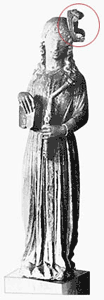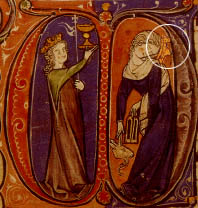|


 Ecclesia
and Synagoga were the names given to the symbolic personification in medieval
Christian art of Christianity's triumph over Judaism. This early type
of anti-Jewish propaganda, which first appeared in the 11th century, was
common decoration in the sculptures, paintings and stained-glass windows
of churches and cathedrals, and in the decorations and bindings of Bibles
and prayer books. Ecclesia
and Synagoga were the names given to the symbolic personification in medieval
Christian art of Christianity's triumph over Judaism. This early type
of anti-Jewish propaganda, which first appeared in the 11th century, was
common decoration in the sculptures, paintings and stained-glass windows
of churches and cathedrals, and in the decorations and bindings of Bibles
and prayer books.
A pair of female statues decorated many Gothic cathedrals and churches
(usually outside the building) in Europe, especially in France, England
and Germany. Ecclesia, representing the victorious, triumphant Church,
takes the form of a proud, erect maiden, crowned and holding the cross.
Synagoga, symbolizing the defeated Synagogue, is blindfolded (symbolizing
blindness to the truth of the New Testament) and dejected, and her characteristic
appurtenances are a broken staff, [1]
broken tablets of the Law (symbolizing the Old Testament), and a fallen
crown.
The best known statues of this type are on the exterior of the cathedrals
of Strasbourg and Bamberg. They are also found in Rheims, Paris and Bordeaux.
In England, they figure (generally in mutilated condition) in churches
in Rochester, Lincoln, Salisbury and Winchester.
Depicted to the right is the Synagoga statue which stood in front of the
Liebrauen Church, Trier, Germany (built c.1250); it presently stands in
the Bischoefliches Museum in Trier. Synagoga is blindfolded, holds a broken
staff and overturned tablets, and her crown is fallen.
|

Click
to view enlargement
|
| These two figures on the left stand at the church of
St. Severin, Bordeaux (erected 1264). While Ecclesia (left)
stands erect and crowned, Synagoga (right) is blindfolded
(a serpent covering her eyes), and the fallen crown lies
at her feet. |
|

Click to view enlargement
|
An example of Ecclesia
and Synagoga's appearance in medieval manuscripts, may be found in the
13th-century missal illustration (below) from the abbey of St. Pierre,
Ghent (now displayed at the Bylcke Museum, France). The haughty maiden
representing the Church holds a standard and chalice in her hands. Synagoga,
in contrast, is bent and distorted; her crown is falling off, and she
holds the Tablets of the Law, a broken scepter, and the head of a goat,
symbol of the devil.[2]

|
[1]
based on OT, Corinthians 3:14 [back]
[2] Paradoxically, the representation
of the blindfold synagogue was reflected even in Jewish manuscript
art,
as for example in the miniature of the blindfold Torah with her spouse,
the People of Israel, in a 14th cent. manuscript prayer book from
Hamburg. [back] |
CROWN
Table of Contents
|